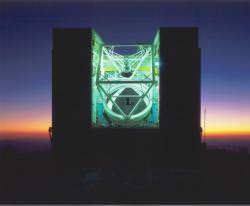We've run a couple of articles recently about new techniques to find Earth-like extra-solar planets. Here's one more, but this new technique is really quite exciting. A new device, called a laser comb, uses femto-second (one millionth of one billionth of a second) pulses of laser light coupled with an atomic clock to provide a precise standard for measuring wavelengths of light. Also known as an "astro-comb," these devices should give astronomers the ability to use the Doppler shift method with incredible precision to measure spectral lines of starlight up to 60 times greater than any current high-tech method, according to a new paper in the journal
Nature
.
Astronomers have been using the Doppler shift method to find exoplanets for the past 10 years. Current technology can measure spectral lines with a precision of 60 centimeters per second, which works good enough to find a planet 5 times the mass of Earth in a Mercury-like orbit around a Sun-like star. To find an Earth-mass planet in an Earth-like orbit, a precision of less than 5 cm per second is necessary, and the researchers believe they ultimately can achieve 1 cm per second precision.
The combs work by creating regular spikes of laser light that are evenly spaced in wavelength "like the teeth of a comb" and can be projected onto a spectrograph.
One of the authors of the paper, Ronald Walsworth from the Harvard-Smithsonian Center for Astrophysics said the group should begin testing its prototype system in June 2008 at the Multi-Mirror Telescope (MMT) Observatory on Mount Hopkins in Arizona. And in 2009 the researchers plan to set up a planet-spotting system at the 4.2-metre William Herschel Telescope on La Palma, in the Canary Islands, in collaboration with the Geneva Observatory.
The inventors of the laser comb, John L. Hall and Theodor W. Hansch shared half of the 2005 Nobel Prize in Physics. This technology has previously been used in chemical sensing and telecommunications. If used with larger telescopes, researchers believe the astro comb could possibly make direct measurements of dark energy.
Original News Sources:
Nature,
and
Nature News
 Universe Today
Universe Today
